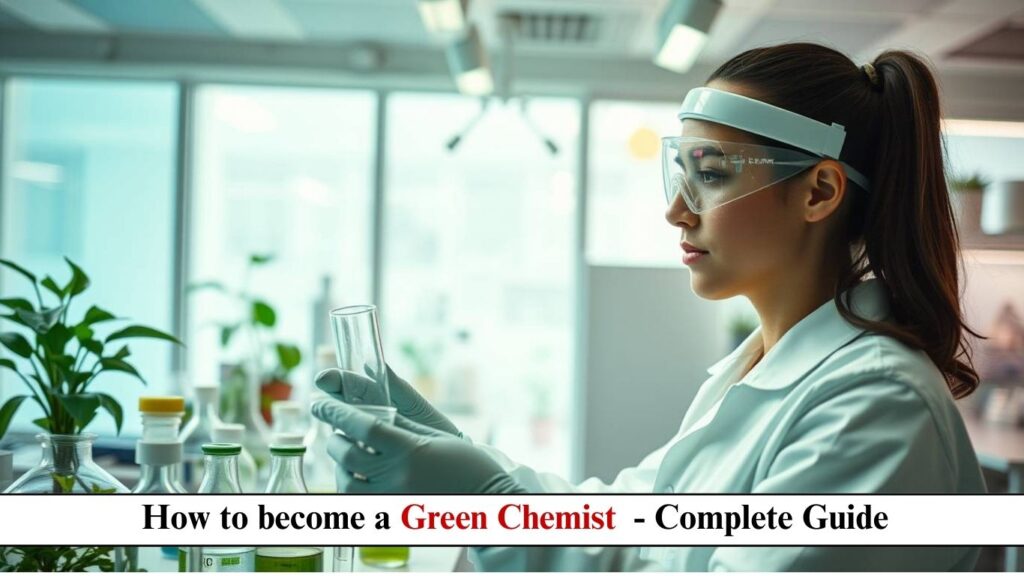
Introduction
As the world shifts toward sustainability, Green Chemistry has emerged as a revolutionary field that reduces environmental harm through smarter chemical design. Green Chemists develop eco-friendly alternatives to toxic substances, create biodegradable materials, and help industries cut pollution.
This guide covers everything you need to know about becoming a Green Chemist, including:
- History of Green Chemistry
- Salary expectations
- Roles & responsibilities
- Required qualifications
- How to get started
- Future career prospects
Whether you’re a chemistry student or a professional seeking a planet-positive career, this guide will help you navigate this growing field.
History of Green Chemistry
Early Environmental Awareness (Pre-1990s)
- 1962: Rachel Carson’s Silent Spring exposed chemical pollution dangers.
- 1970s: EPA formed, regulating toxic chemicals like DDT.
- 1980s: Industrial disasters (Bhopal, Exxon Valdez) highlighted need for safer chemistry.
Birth of Green Chemistry (1990s)
- 1991: Paul Anastas & John Warner coined the term “Green Chemistry”.
- 1998: 12 Principles of Green Chemistry published, defining the field.
- 2000s: Governments incentivized bio-based solvents & renewable feedstocks.
Modern Advancements (2010s-Present)
- 2015: UN Sustainable Development Goals (SDGs) boosted green chemistry adoption.
- 2020s: AI-driven molecular design accelerates sustainable material discovery.
- Today: Green chemistry is a $100+ billion market, growing at 10% annually.
Green Chemist Salary Outlook
Salaries vary by experience, industry, and location:
| Experience Level | Average Salary (USD) | Salary Range (USD) |
|---|---|---|
| Entry-Level (0-3 yrs) | $55,000 – $75,000 | $50,000 – $85,000 |
| Mid-Level (4-7 yrs) | $80,000 – $110,000 | $75,000 – $130,000 |
| Senior-Level (8+ yrs) | $120,000 – $180,000+ | $110,000 – $220,000+ |
Highest-Paying Industries
- Pharmaceuticals (Pfizer, Merck)
- Biotechnology (Amyris, Ginkgo Bioworks)
- Consumer Goods (P&G, Unilever)
- Energy (Renewable fuels sector)
Top-Paying Countries
- USA, Germany, Switzerland, UK, Japan
Roles & Responsibilities
Green Chemists work across industries to reduce toxicity, waste, and energy use.
1. Research & Development
- Design biodegradable plastics (e.g., PLA from corn starch)
- Develop non-toxic solvents (replacing petroleum-based ones)
- Optimize catalytic processes to reduce waste
2. Process Engineering
- Scale lab discoveries to industrial production
- Implement atom-economical synthesis (maximizing resource efficiency)
3. Regulatory & Compliance
- Ensure products meet EPA, REACH, and FDA standards
- Prepare Environmental Impact Assessments (EIAs)
4. Corporate Sustainability
- Help companies transition to green chemistry
- Conduct life-cycle assessments (LCAs) of products
5. Academia & Policy
- Teach green chemistry principles
- Advise governments on chemical regulations
Qualifications & Skills Needed
1. Educational Background
- Bachelor’s Degree (minimum):
- Chemistry
- Chemical Engineering
- Environmental Science
- Master’s/PhD (for research roles):
- Green Chemistry
- Material Science
- Biotechnology
2. Key Skills
- Technical Skills:
- Organic synthesis
- Spectroscopy (NMR, HPLC)
- Computational chemistry (Gaussian, Schrödinger)
- Soft Skills:
- Problem-solving
- Cross-disciplinary collaboration
- Regulatory knowledge
3. Helpful Certifications
- ACS Green Chemistry Certificate
- LEED Green Associate
- ISO 14001 (Environmental Management)
How to Get Started
1. Education Path
- Take green chemistry courses (e.g., ACS’s online programs)
- Pursue internships at sustainable chemical companies
2. Gain Experience
- Work in R&D labs (even traditional chemistry roles)
- Volunteer for environmental NGOs (e.g., EDF, Greenpeace)
3. Build Specialized Knowledge
- Learn biosynthesis (enzymatic reactions)
- Study circular economy principles
4. Networking
- Join ACS Green Chemistry Institute
- Attend Green Chemistry & Engineering Conference
5. Job Hunting
- Look for titles like:
- Sustainable Materials Scientist
- Eco-Design Chemist
- Environmental Process Engineer
Future Career Scope
The green chemistry field is booming due to:
1. Regulatory Drivers
- 2025: EU’s Chemical Strategy for Sustainability bans harmful substances
- 2030: Global push for carbon-neutral manufacturing
2. Industry Adoption
- Fashion: Developing non-toxic dyes (e.g., Colorifix)
- Agriculture: Creating biodegradable pesticides
- Energy: Designing eco-friendly battery chemicals
3. Technological Innovations
- AI for molecular design (e.g., Google’s DeepMind for protein folding)
- Enzymatic recycling of plastics
4. Career Growth Areas
- Startups: Bio-based material companies (e.g., Ecovative)
- Government: EPA, DOE research roles
- Consulting: Helping firms green their supply chains
Conclusion: Why Become a Green Chemist?
This career offers:
✔ High earning potential
✔ Tangible planetary impact
✔ Diverse industry opportunities
Next Steps:
- Specialize (e.g., in biofuels or green polymers)
- Contribute to open-source research (like PubChem Green)
- Mentor with ACS Green Chemistry members
Have questions? Ask below! Let’s build a greener chemical future together. 🌿⚗️













Post Comment